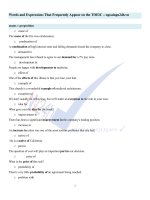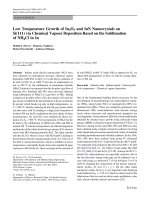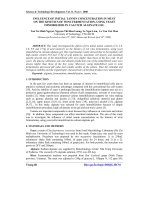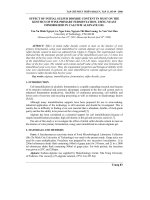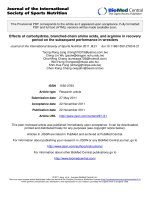INFLUENCE OF STRUCTURAL AND CHEMICAL ASYMMETRY OF NANOSTRUCTURES ON THE KINETICS OF WETTING
Bạn đang xem bản rút gọn của tài liệu. Xem và tải ngay bản đầy đủ của tài liệu tại đây (5.13 MB, 236 trang )
INFLUENCE OF STRUCTURAL AND CHEMICAL
ASYMMETRY OF NANOSTRUCTURES ON THE
KINETICS OF WETTING
LAI CHANGQUAN
(M. Eng., MIT; B. Eng. (Hons.), NUS)
A THESIS SUBMITTED
FOR THE DEGREE OF
DOCTOR OF PHILOSOPHY
IN ADVANCED MATERIALS FOR MICRO- AND
NANO- SYSTEMS (AMM&NS)
SINGAPORE-MIT ALLIANCE
NATIONAL UNIVERSITY OF SINGAPORE
2014
i
Declaration
I hereby declare that this thesis is my original work and it has been written by
me in its entirety. I have duly acknowledged all the sources of information
which have been used in the thesis.
This thesis has also not been submitted for any degree in any university
previously.
______________________________
Lai Changquan
17 February 2014
ii
Acknowledgements
I would not be here, if not for the following institutions and people.
Singapore-MIT Alliance, both the offices and the program, for the
provision of a bond-free scholarship and excellent administrative execution.
Prof. Thompson, whose commitment to the quest for scientific truth
and knowledge is an inspiration to me on so many levels. I am truly indebted
to him for so many of the skills I have picked up in these last few years.
Prof. Choi, whose heart for students I admire and appreciate greatly.
He has been a great source of encouragement in my research and has taught
me much about directing and driving the development of projects.
Colleagues from AMMNS ’09 (SMA), Microelectronics lab (NUS)
and AMMNS lab (MIT), who have enriched my graduate school experience
with unabashed quests for free food, unforgettable trips within and outside of
Cambridge city, unshakeable friendships forged in the furnace of intense cram
sessions and unguarded discussions about life, religion and science.
Friends, including Lester, Derek, Glynn, Kendrick, Vinca, Fuiyen,
Siewshin and the associated groups for always looking out for me and
supporting me in whichever way they can.
Family, especially my father and mother, who did everything they
could to make sure that I received a good education, despite having little
schooling themselves. My sister and brother also, for their constant
encouragement in difficult times.
iii
My wife, for loving me and reminding me that she loves me, regardless
of how my research (and life) turns out.
Lastly, I would like to dedicate this work to God, the architect of the
discoveries presented here, who guided a lost little boy to his passion for
science and showed him that that all things are possible through Christ (Phil
4:13).
iv
Table of Contents
Summary ix
List of Tables xi
List of Figures xiii
List of Symbols xxvi
Chapter 1 Motivation and Scope 2
1.1 Introduction 2
1.2 Contents of this Thesis 4
References 5
Chapter 2 Wetting Models and Characterization Techniques 8
2.1 Wetting on a Flat Solid Surface 8
2.2 Wetting on Nanostructures 10
2.3 Macroscopic Apparent Contact Angle and Microscopic Intrinsic
Contact Angle 12
2.4 Thermodynamics of Wetting 14
2.4.1 Thermodynamic Equilibrium Apparent Contact Angle 14
2.4.2 Triple Phase Contact Line Pinning 18
2.4.3 Thermodynamic Condition for 2D Wicking 22
2.5 Kinetics of Wetting 23
v
2.5.1 Capillary-Inertia Regime 23
2.5.2 Capillary-Viscous Regime 25
2.5.3 Transition from the Capillary-Inertia Regime to the Capillary-
Viscous Regime 30
2.5.4 Rate of 2D Wicking 31
2.5.5 Uniaxial Wetting 32
2.5.6 Directional Wetting 35
2.5.7 Directional Wicking 36
2.6 Characterization of Wetting 38
2.6.1 Sessile Drop Technique 38
2.6.2 Wilhelmy Plate Method 40
2.6.3 Sliding Droplet Method 42
2.7 Summary 43
Chapter 3 Fabrication of Nanostructures 47
3.1 Introduction 47
3.2 Interference Lithography with Lloyd’s Mirror Setup 48
3.3 Metal Assisted Chemical Etching 52
3.4 Low Power O
2
/CF
4
Plasma Etching 57
3.4.1 Introduction 57
3.4.2 Experimental Procedure 58
vi
3.4.3 Effect of Plasma Concentration on Etch Anisotropy 61
3.4.4 Effect of Plasma Composition on Surface Energy of PS 69
3.4.5 Stitch Etching 70
3.4.6 Application of Plasma Etching and Stitch Etching Techniques to
Different Polymeric Substrates 74
3.4.7 Application to Superhydrophobic Surfaces 75
3.5 Conclusions 80
Chapter 4 Manipulation of Wetting Directions Using
Nanostructures with Asymmetric Surface Energies 88
4.1 Introduction 88
4.2 Experimental Methods 91
4.3 Details of Geometry and Surface Chemistry of Nanostructures 94
4.4 Effect of Nanostructured Surface Energy Anisotropy on Wetting
Directions 99
4.5 The Composite Effects of Structural and Surface Energy Anisotropy
on Wetting Directions 100
4.6 Quantitative Model 104
4.6.1 Derivation of the Wetting Force 106
4.6.2 Derivation of the Pinning Force 107
4.7 Comparison between Model and Experimental Results 118
vii
4.8 Effect of Metal Oxidation on Directional Wetting 123
4.9 Conclusions 127
Chapter 5 Kinetics of Two Dimensional Wicking in
Nanostructures 132
5.1 Introduction 132
5.2 Experimental details 134
5.3 Rate of Wicking into Isotropic Nanopillars 136
5.3.1 Theoretical Model 136
5.3.2 Comparison between Model and Experimental Results 143
5.4 Rate of Wicking into Anisotropic Nanofins 151
5.4.1 Theoretical Model 153
5.4.2 Comparison between Model and Experimental Results 158
5.5 Conclusions 161
Chapter 6 Kinetics of Droplet spreading on a Two Dimensional
Wicking Surface 165
6.1 Introduction 165
6.2 Experimental Procedure 166
6.2.1 Fabrication of nanostructures 166
6.2.2 Characterization of the Droplet Spreading Process 168
6.3 Kinetics of Droplet Spreading on Isotropic Nanopillars 169
viii
6.3.1 Results and Observations 170
6.3.2 Theoretical Model 172
6.3.3 Comparison between Model and Experimental Results 177
6.4 Kinetics of Droplet Spreading on Structurally Anisotropic Nanofins
184
6.4.1 Effects of Structural Anisotropy 184
6.5 Kinetics of Droplet Spreading on Chemically Asymmetric
Nanopillars 193
6.6 Conclusions 196
Chapter 7 Conclusions and Recommendations for Future Work . 201
7.1 Conclusions 201
7.2 Recommendations for Future Work 205
7.3 List of Publications 208
ix
Summary
The kinetics of wetting of a liquid droplet deposited onto a surface
consisting of ordered arrays of nanostructures with either structural or
chemical asymmetry was studied. Structurally anisotropic Si nanostructures
were obtained by fabricating elliptical nanofins using interference lithography
and metal assisted chemical etching. Chemically anisotropic nanostructures,
on the other hand, were obtained by the oblique angle deposition of a metal
onto an array of polystyrene nanostructures fabricated by interference
lithography and O
2
/CF
4
plasma etching.
It was found that when there is chemical asymmetry, that is, a
difference between the surface energy of the two faces of a nanostructure, an
uneven pinning strength on the triple phase contact line causes preferential
wetting to occur on the more hydrophilic face. Depending on the shape of the
nanostructure, which can be controlled by the fabrication process, wetting can
be made uni-, bi- or tri-directional.
For the case of chemically homogeneous nanostructures, it was found
that when the nanostructures are sufficiently rough, a form of wetting different
from Wenzel and Cassie-Baxter states will arise. This form of wetting is
commonly known as hemiwicking or 2D wicking, and involves a film of
liquid wicking from the base of the droplet into the space between the
nanostructures. The rate of imbibition of the wicking film is determined by the
balance between capillary energy gained from wetting the nanostructures and
energy losses in the form of skin drag and form drag. It was found that skin
drag tends to be stronger along the length of the nanofins while the converse is
x
true for form drag. Therefore, depending on the exact geometry of the
nanofins, the wicking film may adopt an isotropic or anisotropic shape on
nanofin arrays.
In contrast, droplets spreading on 2D wicking surfaces made of
nanofins are always isotropic in shape. This can be attributed to the
elimination of contact line pinning by the wicking film which, by advancing
ahead of the droplet edge, causes the droplet to effectively spread on a flat,
composite surface made up of solid and liquid phases.
xi
List of Tables
Table 3-1: Measurements of water contact angle exhibited by the various
nanostructures. Long-axis and short-axis refer to the axis parallel to the long
and short side of the nanofins/ nanogrooves respectively. The water droplet
was viewed with the respective axis pointing into the screen and water contact
angles were measured from this view. 77
Table 4-1: Processing and geometric parameters for freshly fabricated samples.
The last column shows schematic diagrams of the respective nanostructures
(Yellow: Metal coated regions White/Gray: Uncoated regions). The arrows
next to them indicate the directions of wetting due to anisotropic surface
energies of the nanostructures (wetting directions due to topography not
included). Measurements of p, q, w and v are taken at the tips of the
nanostructures. 98
Table 5-1: Critical contact angle (θ
c
) for silicon nanopillars. 143
Table 5-2: Geometrical parameters of nanofins used in this study where h
refers to the height of the nanofins, and definitions of p, q, m and n can be
found in Figure 5-9. All dimensions, except for r and
s
, which are
dimensionless, are in μm. 152
Table 6-1: Geometric properties of Si nanopillars used to produce
experimental data in Figure 6-5 below. d refers to the diameter of the
nanopillars, h refers to the height of the nanopillars, λ refers to the period of
the nanopillars and V refers to the volume of droplet deposited onto the
nanopillars.
s
can be found by taking
d
2
/4λ
2
. 169
xii
Table 6-2: Geometric properties of Si nanopillars used to produce
experimental data in Figure 6-6 below. r refers to surface roughness which can
be found by taking
dh/λ
2
+ 1. 170
Table 6-3: Geometric properties of Si nanofins used in this study. The various
geometric parameters, p, q, m and n have the same meaning as those in
Chapter 5, specifically that of Figure 5-9. 185
Table 6-4: Geometric properties of PS nanopillars used in this study. The
various geometric parameters, p, q, m and n have the same meaning as those in
Chapter 5, specifically that of Figure 5-9. Pillar A refers to the sample with
hydrophobic PS and Pillar B refers to the sample with hydrophilic PS. 194
xiii
List of Figures
Figure 2-1: Surface tension forces acting on the triple phase contact line of a
droplet spreading on a chemically homogeneous and smooth surface. 9
Figure 2-2: Schematic diagrams showing the three possible states that can be
adopted by a droplet spreading on nanostructured surface. (a) A fakir droplet
sitting atop nanostructures (Cassie-Baxter state). (b) A droplet infiltrating the
space between the roughness of a surface (Wenzel state) and (c) a droplet
imbibing the roughness ahead of the droplet edge (2D wicking state). 10
Figure 2-3: (a) PDMS droplet on Si microchannels coated with fluorodecyl-
POSS (polyhedral oligomeric silsesquioxane). (Insets) Side view of decane
droplets, which have similar surface tension values as PDMS, on the same Si
microchannels, along different axes. Magnified view of droplet edge (b)
advancing and (c) receding along the y-axis. Magnified view of the droplet
edge (d) advancing and (e) receding along the X-axis
6
. 12
Figure 2-4: Free energy vs instantaneous water contact angle on a rough
surface (r = 1.1,
= 64.3°). The smooth line represents calculations for
wetting in the direction parallel to the microchannels while the undulating line
represents calculations for wetting in the direction perpendicular to the
microchannels
14
18
Figure 2-5: Side view of contact line pinning on the top edge of a
nanostructure for (a) an advancing droplet edge (contact line is moving to the
right) and (b) a retracting droplet edge (contact line is moving to the left). 19
xiv
Figure 2-6: Water droplets spreading on a flat, smooth surface (
= 43°)
16
. 23
Figure 2-7: Schematic illustration of a droplet edge moving to the left
18
. 26
Figure 2-8: (a) A water droplet spreading anisotropically on PDMS
microchannels
14
. (b) Schematic diagram showing contact line pinning as the
droplet edge moves from hydrophilic SiO
2
(gray) strip to hydrophobic PFDTS
strip (orange). 33
Figure 2-9: (a) Top view of unidirectional wetting on bent Si nanopillars
21
. (b)
Bent polymer (PUA) nanopillars
22
. (c) Bent Si nanopillars
21
. (d) Slanted
polymer (Parylene) nanopillars
23
. 35
Figure 2-10: (a) Directional wicking on microtriangles
24
. (b) Schematic
diagrams from the top view showing how the shape of the wicking front can
cause Laplace pressure to enhance or retard wicking rates
25
. 37
Figure 2-11: (a) Schematic diagram of setup used to measure the contact angle
of a sessile drop on a surface. (b) Image of a droplet on a flat surface of
Polystyrene (
= 83.5°). 38
Figure 2-12: Schematic diagram illustrating how the sessile drop technique is
used to measure (a) the advancing contact angle and (b) the receding contact
angle. 39
Figure 2-13: Schematic diagrams illustrating the concept of the Wilhelmy
plate method. (a) The advancing angle is measured by inserting the substrate
into a bath at constant speed. (b) The receding contact angle is measured by
retracting the substrate from the bath at constant speed. 40
xv
Figure 2-14: Schematic diagram illustrating the concept of the sliding droplet
method. A droplet on a surface is tilted at incremental angles until the point
where it begins to slide down the slope. 42
Figure 3-1: Schematic diagram illustrating the working principle of
interference lithography with Lloyd’s mirror setup. The blue triangles indicate
the path of the beams. The light orange areas in the photoresist represent the
bright strips of the interference pattern. 48
Figure 3-2: Types of nanoscale patterns that can be obtained with interference
lithography and Lloyd’s mirror setup. Blue strips represent the bright fringes
of the interference pattern. (a) Single exposure to the interference pattern
yields 1D gratings. (b) Two exposures at an angle less than 90° to each other
yields a hexagonal array of ellipses. (c) Two exposures at 90° to each other
yields a square array of dots 52
Figure 3-3: Schematic diagrams showing the MACE process on a Si
substrate
19
. Au is the noble metal catalyst. The cathodic reaction (*) takes
place on the surface of the gold while the anodic reaction (#) takes place on
the silicon surface. Red arrows indicate the transfer of h
+
from the cathode to
the anode/solution interface. 53
Figure 3-4: Si nanowires fabricated on lightly doped p-type wafer using Ag
nanoparticles
20
55
Figure 3-5: Schematic diagrams describing the process flow for the fabrication
of polymeric nanostructures using low power CF
4
/O
2
plasma etching. 59
Figure 3-6: SEM pictures of nanofins obtained when the amount of CF
4
indicated in the top left corner is present in the plasma. The nanofins have
xvi
elliptical cross-sections and are arranged hexagonally. They are categorized
into 4 types (I-IV) and schematic diagrams illustrating the characteristic
morphologies for each type are shown on the right of each row. Note that
charging effects in the SEM caused the nanofins fabricated with 100% CF
4
plasma to seem slightly slanted. Scale bars represent 2μm. 63
Figure 3-7: (a) Percentages of fluorine and oxygen found on the PS surface
after plasma treatment. (b) Etch anisotropy, etch rate and polymerization rate
with respect to plasma composition. The best fit line for etch anisotropy data
points within each regime is also included. The range of plasma compositions
that corresponds to the different types of nanofins in Figure 3-6 (regimes I –
IV) have been color coded. Error bars indicate the standard deviation in
measured values. 65
Figure 3-8: Water contact angles for O
2
/CF
4
plasma treated polystyrene. 69
Figure 3-9: Stitch etching demonstrated with a rectangular arrangement of
circular holes and isotropic etching. (a) Etch depth ≈ 0. (b) Etch depth = 0.5λ.
(c) Etch depth = 0.55λ. (d) Etch depth = 0.7λ. λ refers to the period of the
holes. The transparency of the model is varied for clarity. 71
Figure 3-10: High aspect ratio nanostructures obtained by stitch etching. (a)
Nanopillars (b) Nanofins (inset: magnified view) (c) Ribbed nanogrooves and
(d) Zig-zag rows of nanopillars (inset: top view. The positions of some
nanopillars are highlighted in red to reveal the zig-zag arrangement).
Schematic diagrams showing the formation of the structures from fin holes are
shown on the bottom left. Scale bars represent 2μm. 73
xvii
Figure 3-11: SEM pictures of (a) nanopillars on PS (b) nanogrooves on PS (c)
nanogrooves on PP (d) nanopillars on PP (e) nanopillars on Kapton® PI and (f)
stitch etched nanopillars on PET formed from a rectangular array of holes.
Low power plasma etching was carried out with gas comprising 70% CF
4
and
30% O
2
. Etch anisotropy for nanopillar and nanogroove patterns on PS are
similar to that of nanofin patterns. Scale bars represent 2μm. 75
Figure 3-12: (a) Non-stick property of surface with zig-zag rows of nanopillars
demonstrated with a 6μl water droplet. (b) Sliding of 6.4μl droplet over a
distance of 3.5mm on a level surface textured with zig-zag rows of nanopillars.
(c) Bouncing 6.4μl droplet on zig-zag rows of nanopillars. (d) 1μl droplets
trapped on 0.5mm x 0.5mm hydrophobic pads surrounded by
superhydrophobic nanopillars. (e) (i) Top view and (ii) side view of 20μl of air
bubbles trapped on 2mm x 2mm of superhydrophobic pads surrounded by
hydrophilic untreated PS (water contact angle = 83.5°±4.4°). Scale bars
represent 2mm. 78
Figure 4-1: Summary of the fabrication process for nanostructures with
anisotropic surface energies. The first 2 rows illustrate the patterning process
and the last row shows the pattern transfer via plasma etching and generation
of surface energy asymmetry. 91
Figure 4-2: Schematic diagrams of the (a) top view and (b) side view of
nanofins. SEM images of (c) hydrophilic nanogrooves (d) hydrophobic
nanofins and (e) hydrophobic nanopillars taken at a 45° tilt with top view
images as insets. Each scale bar represents 2μm. 96
xviii
Figure 4-3: Side view of directional wetting on surfaces with periodic
nanogrooves, nanofins and nanopillars. (Insets) Schematic diagrams showing
the orientation of the asymmetric coating on the respective nanostructures.
Scale bar represents 1mm. 100
Figure 4-4: Uniaxial wetting on (a) nanogrooves and (b) nanofins. 101
Figure 4-5: Top views of (a) uni-directional wetting, (b) tri-directional wetting
and (c) bi-directional wetting on anisotropically coated nanofins. An image of
a clam-shaped droplet exhibiting tri-directional wetting is shown in the bottom
right corner of (c), for contrast with the elbow-shaped droplet exhibiting bi-
directional wetting in the bottom left corner of (c). Note that this droplet
exhibiting tri-directional wetting has a higher contact angle than the one
shown in (b). (Insets) Schematic diagrams showing the orientations of the
nanofins and the anisotropy of their coatings from the top view. Yellow
arrows indicate the wetting directions. Scale bars represent 5mm for (a) and (b)
and 1mm for (c). 102
Figure 4-6: Top views of uni-directional wetting on nanopillars that are
anisotropically coated in the directions (a) β = 207° and (b) β
= 225°.
Schematic diagram shown beside each picture indicates the movement of the
wetting front over the pillars. The yellow arrow indicates the wetting direction
which is always opposite to the metal deposition direction and the blue shaded
areas on the nanopillar array indicate the wetted regions. Scale bars represent
1mm. 103
xix
Figure 4-7: Schematic diagrams showing the period, P, for wetting of nanofins
along the (a) Y-axis and (b) at an angle of 27° to the Y-axis. Green arrows
indicate wetting directions and are normal to P 106
Figure 4-8: (a) Schematic diagram showing the various positions of the LVS
as it moves past a nanostructure from left to right. (b) Magnified view showing
the relaxation of the LVS from θ
ps
to θ
mtl
on a nanostructure with a wide top.
(c) Magnified view showing the relaxation of the LVS from θ
ps
to θ
mtl
on a
nanostructure with a narrow tip. (d) Magnified view showing the pinning of
the LVS at the top of the nanostructure. Note that the area to the left of a LVS
is filled with liquid whereas the area to the right of a LVS is not. Blue and red
lines represent positions of the LVS before and after overcoming the pinning
at the nanostructure, respectively. Green arrow indicates the direction of
wetting 108
Figure 4-9: Schematic diagrams showing the movement of the LVS over a
nanostructure with hydrophobic floor. Red lines indicate the positions of the
LVS after it has overcome pinning forces at the top of the nanostructures.
Purple lines and font highlight modified parameters. Green arrow indicates the
direction of wetting. 112
Figure 4-10: Schematic diagrams showing the movement of the LVS over a
nanostructure in the direction of the uncoated face. (b) Magnified view
showing the LVS pinned at the transition from metal to PS with a local contact
angle greater than θ
mtl
when wetting in the direction of the uncoated face. (c)
Magnified view showing the LVS unaffected by the transition from metal to
PS as it is able to reach the slope
rest
, which is before or at the transition point
xx
at which it can relax to form a local contact angle of θ
mtl
. Purple lines and font
highlight modified parameters. Green arrows indicate the directions of wetting.
113
Figure 4-11: (a) Schematic diagram showing a nanopillar modelled as a
tapered rod with a truncated spherical cap as a tip. (b) Schematic illustration
showing the reduction of the pinning length at the tip as the wetting front
advances across a nanopillar. (c) Side view of the process in (b). Black lines
represent the resting position of the wetting front and red lines represent the
critical point when the pinning force at the tip is overcome and the liquid is
allowed to travel down the nanopillar. (d) Top view of the process in (b). The
dark blue arrow indicates the direction of rotation of the wetting front from the
black lines to the red lines. 115
Figure 4-12: A unit cell of nanofin. 116
Figure 4-13: Computed values of b in the metal coated and uncoated directions.
When not otherwise indicated, β = 180° and the metal coating is Al (
mtl
=
22.2°). Hydrophilic and hydrophobic polystyrene surfaces have
ps
= 74.6
o
and
ps
= 114.8
o
, respectively. Note that for (Hydrophobic fins, β
= 210°), surface
energy anisotropy is present along both the X-axis and Y-axis (see Figure 4-2a).
119
Figure 4-14: Comparison between theoretical and experimental /
eqb
.
“Anisotropic Axis” refers to the axis with anisotropic surface energy while
“Isotropic Axis” refers to the perpendicular axis where anisotropic surface
energy is absent. Error bars indicate the standard deviation in measured values.
121
xxi
Figure 4-15: Theoretical and experimental values of spreading anisotropy. β
=
180° and the metal coating is Al (
mtl
= 22.2°) unless specified otherwise.
Hydrophilic and hydrophobic polystyrene surfaces have
ps
= 74.6° and
ps
=
114.8
°
respectively. Schematic diagrams that summarize the form of wetting
obtained with each sample type are shown above the data bars. The lengths of
the red arrows qualitatively represent the extent of spreading in a particular
direction. The theoretical S.A. for hydrophilic grooves is not given but its
experimental value is shown for purposes of comparison. Error bars indicate
the standard deviation of measured values. 123
Figure 4-16: (a) Increasing hydrophobicity of nanofins over time. The red
dashed line indicates the centre of the droplet before contact with the substrate
was made. +Y indicates the direction of the metal coated face. The number of
hours after metal deposition is given at the bottom right of each photograph.
Scale bar represents 1mm. (b) Change in contact angles of Al and Ni on PS
over time. Error bars indicate standard deviations of the measured values.
Lines that join up the data points have been included to assist in the reading of
the trends. 125
Figure 4-17: Evolution of θ, θ
eqb
and S.A. with respect to changes in θ
mtl
. The
data points correspond to measurements taken at 0, 20, 44, 72 and 144 hours
after metal deposition. The experimental data points and theoretical curves of
related measured values are given in the same colour. Error bars indicate the
standard deviation of measured values. 126
Figure 5-1: Schematic diagram of the process flow for fabrication of Si
nanopillars. 134
xxii
Figure 5-2: SEM images of (a) Si nanopillars of height (i) 2μm, (ii) 4μm and
(iii) 7μm and (b) Si nanofins of height (i) 1.5μm (ii) 2.6μm and (iii) 3.1μm.
Top views of the respective nanostructures are shown in the insets 135
Figure 5-3: Approximating a unit cell (indicated by dashed black lines) of
nanopillars as a unit cell of nanochannel that holds the same volume of liquid.
(a) Top view of a unit cell. (b) Top view and (c) side view of a nanochannel.
The yellow regions indicate the top of the nanostructures at y = h, which
remains dry throughout the wicking process, while the violet regions indicate
the bottom regions at y = 0. Flow of fluid is in the z-direction in all cases. 138
Figure 5-4: Plot of F vs (a) m when n = 0 and (b) n when m = 0. w is fixed at 1
and h is fixed at 2. 140
Figure 5-5: Snapshots of the wicking process of silicone oil on silicon
nanopillar surface (Sample B). The red dotted line marks the liquid front. 144
Figure 5-6: Plot of distance travelled by the wicking front against the square
root of time for nanopillars deposited with silicone oil. 145
Figure 5-7: Experimental and calculated values of β. Data points for β
(silicone oil) and β (water) are obtained with silicone oil and water
respectively. Calculation based on our method is represented by a solid line.
Also shown in this figure are the calculated β values of our samples based on
the models of Zhang et al.
4
and Ishino et al.
8
146
Figure 5-8: Comparison of β values obtained by our methods and others for
the micropillars experiment presented in Ishino et al.’s report
8
. Experimental
and theoretical values are plotted as points and lines respectively. The current
model is represented by a solid blue line. Five different test liquids (γ = 2×10
-2
xxiii
N/m) were used and their respective viscosities are given in the legend. d =
2μm and s = 8μm for all experiments. 149
Figure 5-9: (a) SEM pictures of Si nanofins of height (i) 1.47μm (ii) 2.63μm
and (iii) 3.1μm. Top views of the respective nanofins are shown in the insets.
All scale bars represent 2μm. (b) Schematic diagram of the nanofins. The area
of the dark blue region is given by A and the mean velocity of the fluid in this
area is assumed to be zero to represent the loss of driving pressure due to form
drag when wicking occurs in z (normal) direction. Note also that p' << p for
all our samples. The dotted line demarcates a unit cell of the nanofin. 151
Figure 5-10: Representative z vs. t
1/2
plots obtained experimentally for wicking
of silicone oil on a single sample surface. Best fit lines were drawn through
the data points. 153
Figure 5-11: Plot of A vs. pn. Best fit line is drawn through the data points.
Note that the best fit line, which has a gradient value of 0.912, passes through
the origin. 159
Figure 5-12: Experimental values of (1 – f) β vs. h/w. Note that f = 0 for
wicking in z (parallel). 160
Figure 5-13: Plot of β (parallel)/ β (normal) vs. (1-f)(w
n
/w
p
)
2
. β (parallel) > β
(normal) in the orange region and β (parallel) < β (normal) in the smaller
green region. No data points were expected to reside in the white regions.
Only data from samples with h/w > 2 for both z (normal) and z (parallel) were
used in this plot. 161
Figure 6-1: Schematic diagram of setup employed to track droplet spreading
over time. 168
xxiv
Figure 6-2: SEM picture of Si nanopillars. Scale bar represents 2µm. 169
Figure 6-3: (a) Top view and (b) side view a droplet spreading on a 2D
wicking surface. The solid arrow points to the droplet edge while the dashed
arrow points to the wicking front. Scale bar represents 1mm. (c)
Representative plot of a vs t for the droplet edge and wicking front. The
vertical dashed line marks t = 10ms and the curve represents the function a
t
1/2
. 172
Figure 6-4: Schematic diagram showing a droplet spreading on a wicking film
imbibed between the nanopillars. The sides, but not the top, of the nanopillars
are wetted by the wicking film. The size of the precursor film has been
exaggerated for clarity. 173
Figure 6-5: Plots of Eq. (6.12) (solid lines) and Eq. (6.13) (dashed lines) for
various values of
. Experimental data (for
= 56.3°) are plotted as diamonds.
177
Figure 6-6: (a) A representative plot of t versus X. (b) Plot of gradient, 3µ/
γ,
versus r. Dashed line shows the average value of the data points. 180
Figure 6-7: Plot of a vs t. The different lines show the binomial approximation
in Eq. (6.19) carried out to different number of terms respectively. 182
Figure 6-8: SEM images of nanofins viewed at (a) 40° tilt and (b) without tilt.
Scale bars represent 2µm. (c) Anisotropic and (d) isotropic droplet shapes at
different times of wetting. Scale bars represent 1mm. The dotted arrow points
to droplet edge and regular arrow points to edge of wicking film. 184
